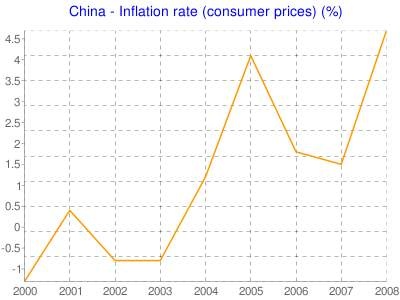Inflation is essentially the rise in general price of goods and services over a period of time in economics. It is more commonly referred to as price inflation in now. It can also be understood as the decline in the real value of money and consumer’s purchasing power. As inflation starts taking its toll, each unit of currency can buy less goods and services compared to what it used to. The primary measure of inflation is the “inflation rate” which represent, Beijing stood under immense pressure from all sides of the coin to raise prices. China has been a victim of inflation in its own right and doubts had been raised by various sectors of the probable inability of the government to control inflation in the concurrent year. In the article chosen, Wen, assured of immediate policies and reforms to counter the aforementioned. Even though the government has increased the interest rates to level the impact inflation out but there is more that needs to be taken care of. China has been witnessing one of the fastest growth rates ever. It was 11.4 % percent in 2007 and it has targeted another 9% in 2008, a target which can be severely affected provided inflation due to food commodities are not dealt with the appropriate reforms and policies as pointed out by Wen. The Keynesian economic theory stipulates that money stands transparent to the real forces in economy. Inflation is most caused by various aspects of the economy translating themselves into higher prices. This is apparently what can be seen in China where high food prices have been the primary cause of inflation. The money supply has an important part to play in determining and chalking out precisely what level of inflation even though different economists have different opinions on the same. Keynesian theories focus more on the aggregate demand which keeps increasing in China owing to its huge population. Thus while, money may be an issue, it is just one of the issues in Keynesian economics.
He stressed on the importance of dealing with inflation as early as possible, failing to do which may cause severe implications on the economy. China has the resources and tools to deal with them, thanks to its oversupply of industrial goods and grains for which if policies are put on board inflation can be cooled down. Wao also tried to alleviate fears exercised by various quarters who felt the targeted 4.8 percent is highly unrealistic as whole sale prices have been witnessing persistent rise and it’s likely that most companies would pass down the impact on the consumers. The following graph illustrates the inflation rates which China’s economy has been able to maintain however the years and indicates the current upward pressure on inflation:

This form of inflation has been explained by Robert J Gordon in his built-in inflation theory. According to Gordon, inflation can also be a result of workers and companies trying to keep their wages high while the high prices are transferred to the consumers. This is what he termed as the vicious circle and is more reflective of the events of the past. (Why Price Stability n.d.)He was of the view that the stipulated goal is a mark of government’s resolve to control inflation and promised market style reforms to help the situation. He believed that by successfully allocating market resources and introducing bank reforms which could help improve inflation.
References
“Why Price Stability”. 2009. Web.